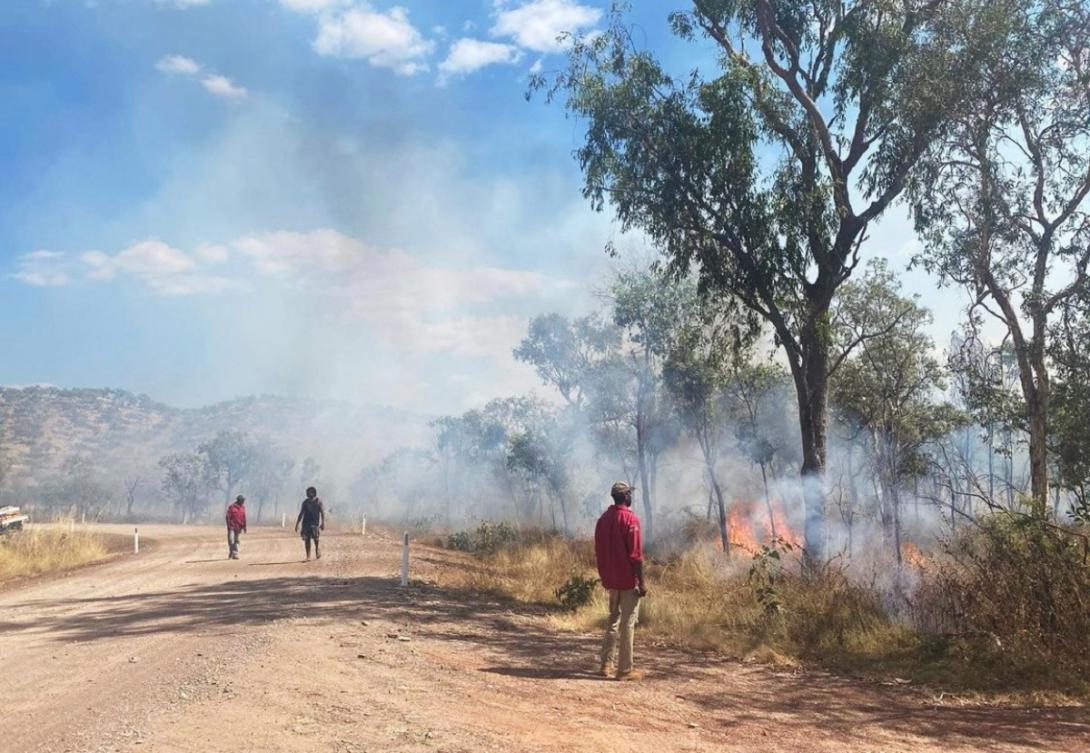Warning
Aboriginal and Torres Strait Islander readers are warned that the following article may contain images of deceased persons.
Northern Australia's savanna wildfires occur during the late dry season (usually August to December). If the land isn't managed to reduce these wildfires, they can burn intensely, at scale, over long periods of time. These fires release substantially more greenhouse gas than early dry season fires which are cooler and patchier, burning less extensively and intensely.
In the eastern Kimberley, Nyaliga Aboriginal Corporation Board member and elder Kathleen O'Reeri knows the damaging impact of uncontrolled late season wildfires all too well.
"In 2016, we had a bad fire; hot weather fire is no good for country and destroys plants and animals," she said.
"Big bush fires burned the whole country pretty bad, but it's improved a lot since then."
Combining traditional Indigenous knowledge with modern technologies, controlled savanna fire management in the early dry season (March to July) is one of the Emissions Reduction Fund (ERF) carbon abatement methods. Cool season burning, and only burning small areas at a time, create a patchwork of firebreaks that limit the number and size of destructive late season wildfires and associated greenhouse gas emissions. Landholders who decrease emissions can earn valuable Australian carbon credits units under the ERF.
In 2020-21, the majority of carbon credits generated by registered Emissions Reduction Fund savanna fire management projects were from projects managed or carried out by Indigenous Australians. One group taking up this opportunity is the Nyaliga Aboriginal Corporation which manages a savanna fire carbon project across 6,400 square kilometres of traditional Country a short distance southwest of Wyndham in Western Australia.
"Our mob's been traditional burning for 60,000 years," Kathleen said.
"It's done to protect our sacred places and makes areas for food gathering and hunting. It looks after our food resources, our culture, and way of living. We call it 'right way' burning. The old people say good fire is about burning the right country at the right time."
Kathleen explained the Corporation started their Emissions Reduction Fund fire project in 2017, the year after the 'bad fire', with support from the Kimberley Land Council. Since then, the amount of their Country burned has reduced by one third, and the area burnt late in the season by two-thirds, and annual emissions have reduced against baseline averages by over 40% on average.
"We work together with the Kimberley Land Council. There's a guy that comes out and does the fire planning with us and we work out together and along with our neighbours and other stakeholders where to burn and where not to burn and when. We check where we had good fires and bad fires every year. We also work with the Wilinggin Healthy Country Advisory Committee which is made up of elders and Traditional Owners from across Wilinggin country.
"The country's improved a lot since then. The trees are better, the grass and wildlife are coming back."
Each carbon credit unit represents one tonne of carbon dioxide equivalent stored or avoided being released into the atmosphere. The carbon credits earned by projects can be sold back to the Australian Government or to businesses to offset their greenhouse gas emissions.
Kathleen said their annual carbon credit income is being used to run the fire management project, including to help employ Nyaliga people as casuals, to provide fire training opportunities, and to ensure the sustainability of the work being done by their new team of six local rangers and Ranger Coordinator. Previously, Nyaliga used to work with the neighbouring Wunggurr Ranger team.
"It also caters for our elders to take our young people back on Country to teach them about our land, law and culture".
"Our elders go out with the rangers and kids during the school holidays – we call them 'Back to Country' trips. We teach about our way of living and our culture, and how to protect our sacred places."
As an elder of her people, Kathleen knows the value of looking after Country and the vital role this fire management project is playing. It is improving the landscape, employing her people, and providing the means to pass on traditional knowledge to the next generation. It also plays a key role in achieving her people's future aspirations.
"We're part of the mob that lives along the Gibb River Road – we're Ngarinyin people. Our clan's homeland is out on the Gibb River, Karunjie Country."
"We want to have ownership of our Country, our homeland, so we can live there as before we were taken off our land. Mainly no one lives out there now, only a caretaker – rangers also go there to check on the growth. We'd love to go back and live there one day."
The Clean Energy Regulator is proud to be part of the Indigenous carbon industry story, healing Country, culture, and the environment.
For more information on savanna fire management projects visit Savanna fire management methods or download this factsheet.
